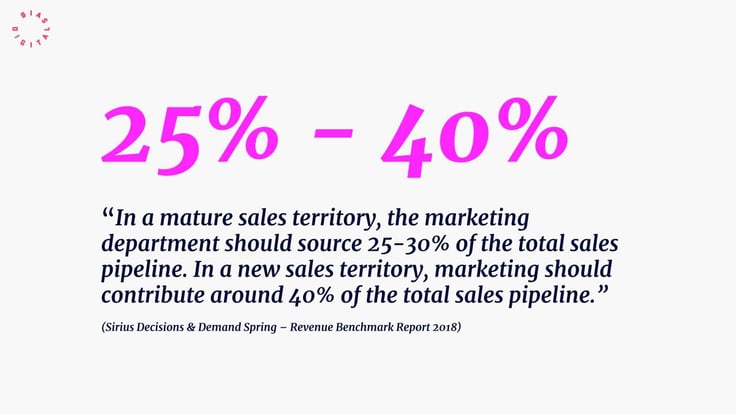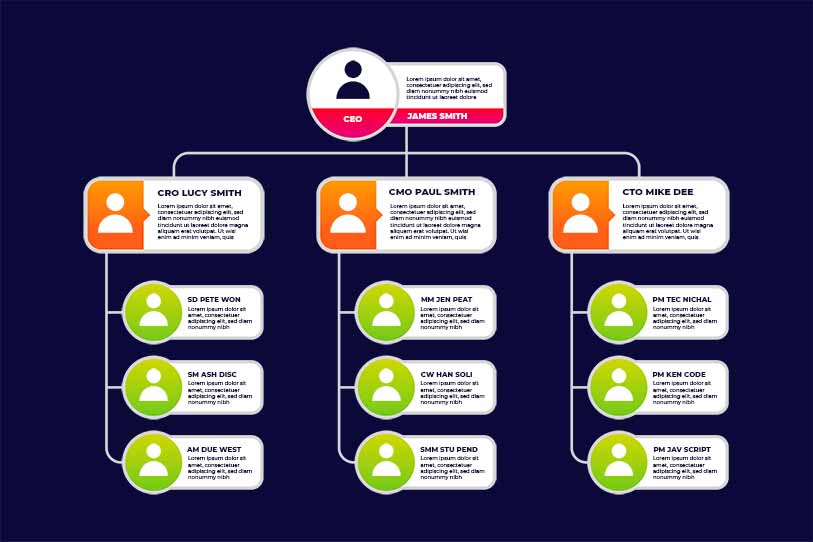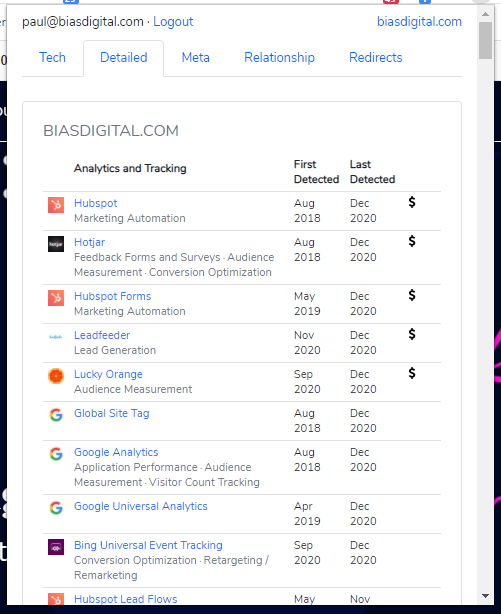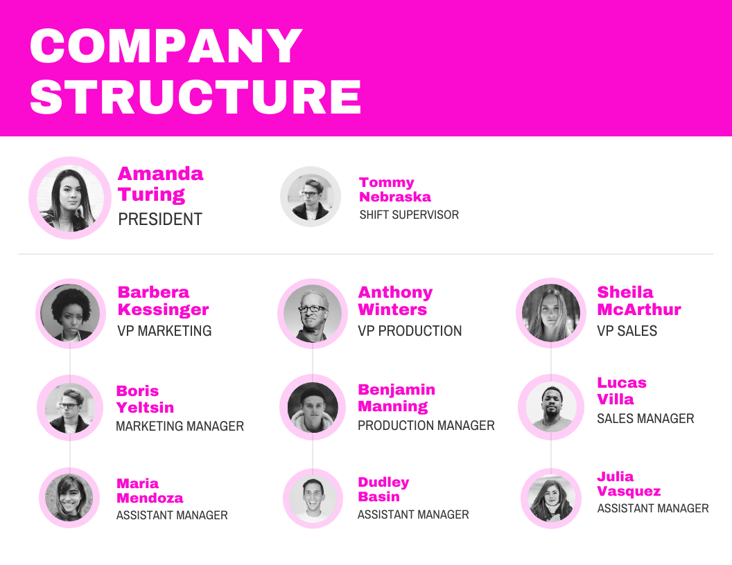Learning how to optimise your sales funnel to increase conversions is an essential part of the day-to-day sales process; however, it isn't the sales team's sole responsibility. Your organisation's marketing department should carry responsibility for the sales funnel too.
According to research from Sirius Decisions & Demand Spring – Revenue Benchmark Report 2018, marketing should contribute somewhere between 25% and 40% of the pipeline, depending on the type of sales territory.

But for the sake of this particular article, let's focus on the stuff that sales reps can manage themselves and the necessary use of the production of content and SEO from the content marketing team. I'm assuming you already have sales automation tools, like HubSpot CRM and HubSpot Sales Pro?
As I have written before, having a standardised sales process in place will always give you better measurable results, but prospecting is where the battle is fought and won.
Sales pipelines fall over because the prospecting activity is sub-par and scattergun. If you currently have an empty pipeline and zero opportunities, it's due to a lack of sales prospecting in the previous months.
What is a sales funnel?
According to Wikipedia, a sales funnel or purchase funnel or purchasing funnel is a consumer-focused marketing model that illustrates the theoretical customer journey toward purchasing a good or service.
That's a great and concise explanation, but if you're reading this, you should already have this knowledge safely tucked away. For those new to this term, I say that a sales funnel is the marketing term for the buyer's journey in today's world.
Companies have aligned their marketing and sales teams to one revenue goal, so the sales and marketing funnel are essentially the same.
Don't worry if your organisation hasn't yet done that; there is still hope for a champion like yourself to start pushing for it. And if you intend to do that, understanding the marketing funnel will be fundamental knowledge.
Understanding the marketing approach to funnel optimization and generating leads is essential. They are supposed to deliver you a plentiful supply of well-educated prospects from their outbound activities.
In the following sections of this article, we will discuss optimising the funnel and your behaviour around it, prospecting, technology and buyer personas.
The sales funnel is broken down into 3 key stages:
-
- Top of the funnel (Tofu)
- Middle of the funnel (Mofu)
- Bottom of the funnel (Bofu)
Much like the marketing funnel, they both look to bring strangers into a sales sequence and onboard them as customers at the end. To be fair, funnels are a little obsolete these days as they imply that as a sales expert, you have done your job once the prospect signs the dotted line.
The truth is, the best sales reps maintain personal relationships with their customer success teams and keep tabs on their client's success with the product or service for a long-lasting relationship. This hands-on relationship will help retention rates and provide a springboard for future upsells or cross-sells.
Those of you who know HubSpot know they suggest that the flywheel is the best method of approaching sales and marketing through lead magnets, landing pages, and conversion paths from your website visitors.
We are a HubSpot agency at Digital BIAS and have developed our proprietary ARISE© framework to support this approach. But we can talk about that later.
Breaking down the sales funnel stages
Let's dive into the individual stages of the funnel, looking at how the sales funnel works, starting with the top of the funnel or TOFU as it is commonly known.
The top of the funnel explained
When potential customers identify a problem that needs solving, they often turn to the internet for answers. 64% of the prospects you talk to will have performed some online research before speaking to your sales team.
At this awareness stage of the sales process, they will identify their challenge and ask questions to search engines or social media platforms to gain answers.
At the top of the funnel, a prospect typically looks for several different options to solve the problem rather than a specific solution.
As with all considered decisions, the prospect will want to feel like they've covered their bases and will have likely searched for an answer in many different ways, using questions, statements and prepositions.
In response to this, your marketing team should write content and produce videos that answer these problems and measure its success through Google analytics. You will then drive potential paying customers to your company blog or other sales pages on your company website.
Once on the website, they need to capture the details of those prospects using calls to action and store those captured details in your CRM so that they become leads.
The middle of the funnel explained
By now, your sales team and marketing team should have agreed on what an ideal client looks like, and those that don't meet that criteria should have been filtered out. This provides the best opportunity for quality candidates to progress down to the bottom of the funnel.
At the middle stage of the sales funnel, your prospects are now aware of what they need to solve their problem and ask more specific questions on the internet or social media channels.
They will know what the specific issue is that they need to solve and are looking for the types of solutions that are available to them.
For example, if their solution is a sales software tool, their initial searches would likely be, "How do I automate my sales process" or "What is the best CRM?".
At the middle stage of the funnel, those searches would morph into something like "What are the best sales automation tools/software for [industry] companies?" or "What are the best CRMs for [industry] companies". Notice how they are now looking for the best options for their type of business or industry.
Hopefully, you have a marketing team producing content that answers those questions. Because once you establish that the prospect has this specific issue, your outbound sales sequences and support materials should be differentiating your solution from the rest.
Ideally, at this point, you would be using marketing automation and or sales automation to follow up and nurture these prospects further. If you haven't yet done this, check out another article we wrote on building your SaaS sales playbook.
The bottom of the funnel explained
Before I continue, I want to clarify my position on the funnels and flywheels we are discussing. I fundamentally believe that we should sell first and nurture later.
Time and again, I see companies that have set up their marketing automation and lead scoring systems; marketing qualified leads (MQLs) to sales qualified leads (SQLs) often based on prospects taking anywhere between 7-12 steps before any human interaction.
I typically see organisations that lead with sales are often more profitable than not because you need to ask, "Are you buying or researching?" and it's challenging to make that happen. But it's not impossible.
Websites are generally our levers to pull or manoeuvre a prospect into a buying conversation, but they are just words and pictures on their own. For those who study the psychology of buying, you know that even those in desperate need of a solution don't pull the trigger; they need prompting. Think chatbots, live chat, sales-based ads and email.
Qualifying the prospect's position in the buying cycle is paramount. But for sales reps, customers never want to tell you where they are in decision-making. So be prepared to work hard to find out. But I digress.
In the final stages at the bottom of the funnel, we expect the prospect primed to buy. Their middle-of-the-funnel searches would have identified the best solutions to their problem.
They will be asking search engines questions like "Who is the best sales automation platform between [option 1] and [option 2]" or if they are price-driven "Which sales automation platform is the best value for money [option 1] or [option 2]". They will check your business out on social media, seeking proof of your product's ability to deliver.
Here, the content you need freely available is FAQs, video demonstrations, live demos, side-by-side evaluations, and case studies. These should lead to personalised requests for demonstrations of your product or service tied directly to that prospect's specific needs. Ultimately, leading to a proposal and negotiation before becoming paying customers by closing the sale.
So how do you optimise your sales funnel?
Sales funnel optimisation is a step-by-step process, focusing on your buyer, and then how to find them before getting into conversations or sales demos before closing them. So here are my tips for successful prospecting, the foundation of an optimised sales process.
Define who your buyer is

The first task you have is to identify who your buyer is. You'll often hear this referred to as your buyer persona. However, personas focus on individuals who form part of the buying process at your target organisations. What I advocate is to build an organisational chart of your target companies so that you can identify who does what. Check out the example below.

By creating a well-discovered org chart, you can highlight which employees would be the influencer and who would sign your contract off. That doesn't mean you are right from your early assumptions, but your job is to learn who has what power.
Think about this. You sell an enterprise SaaS solution. You would likely reach out to the head of sales if it is a sales-aligned solution and the director of marketing or CMO if a marketing tool. While it may seem logical to do so from a sales point of view, they may not have the ultimate buying power nor be influencers in the buying decision.
In addition to those scenarios, they may not be interested in changing the status quo. So your job is to understand the types of companies, startups or small businesses you deal with and know who:
-
- The decision-maker is
- The influencers are
- The person signing off the money is
- The stakeholders are in the buying process.
- Your internal cheerleader/project sponsor will likely be
By arming yourself with all of this information and mapping out their organisational chart, you will soon develop good habits and recognise when challenges or questions need answering and how to solve them.
If you use HubSpot, search for the OrgChartHub add-on and use this to build out the company structure.
Identify what triggers their buying activity
Just because your product looks like an ideal fit for your target prospecting list, it doesn't mean they want or need it. There are a few things that the savvy salesperson would do to mitigate the likelihood of interrupting someone who isn't looking for a product or service like yours.
Firstly, if I'm selling a SaaS solution, I would sign up for a chrome browser application that enabled me to discover what technology is currently in use via the prospect's website. Most sales and marketing software gets connected to the website so look for Snovio Web Tech Checker, Builtwith Tech Profiler, Wappalyzer or Whatruns.

When you use software like this, you can see the technologies already in play and whether yours is better, complimentary or not as good as the incumbent's. Knowing this will help with your sales conversation and show that you have done your research.
Additionally, you should look at the company's LinkedIn page, google the business and its leadership team and check out its social media. Look for news on company growth, recruiting, profits, losses, and anything that can benefit your outreach and further personalise it.
Map your customers buying cycles
The best sales reps understand their marketplace they will:
- Know the top three or four reasons a prospect buys a product or service like yours.
- Know what the standard objections are and how to overcome them.
- Spend numerous hours talking to current customers, quizzing them on what was going on in the organisation to prompt the purchase at this time.
- Know how long a decision will usually take depending on the number of stakeholders involved.
- Know the typical sign-off process and be well prepared to provide what is needed when documents are required.
They know so much about their target market that they get up in the morning and cannot wait to get to work. The best sales reps know that they have to know their customers inside out to succeed, which means optimising oneself to a single outcome. Become an expert on the product, service and customer.
Only you can bring that kind of personal application to the table. Once achieved, you will start filling your pipeline with opportunities to convert.
Design your daily prospecting strategy
Upon reading this, you may feel I have covered prospecting in-depth in this article. However, many people know what they should be doing to fill their funnel but rarely achieve it. Typically because they never build a structure around their day-to-day activities, it becomes easy to "wing it" or procrastinate.
A good sales rep gets routine into their day, and it could look something like this:
-
- Grab coffee
- Build a list of prospects based on personas and trigger events
- Identify the top 30 opportunities.
- Research them on Linkedin, Google
- Find their contact details (Zoominfo, Seamless.ai, Hunter.io, etc.)
- Use your pre-written outreach email template and customise it for each individual.
- Add a task in your CRM to make a call in 2 days.
- Lunch
- Attend to email replies
- Make or return any outstanding calls.
- Catch up with any newly onboarded customers.
- Ask for referrals from satisfied customers.
- Plan for tomorrows day and do any prep that is needed
- Go home or take out a client.
- Rinse and repeat.
Whatever you choose to do as a sales rep, having structure makes for good habits, good habits bring success, and success brings reward. Combined means as a salesperson, you are preparing to build a well-optimised sales funnel.
If you read this article and feel you can take away pointers for your sales process, that's great. The linked articles should also be read to give you greater context. This article was updated on 23/12/2021.
However, if you are looking for an agency to help set up your sales environment, be that CRM or CRM migration, sales materials or a full-on sales enablement program, please book some time with our team here directly.

%20small.jpg)


